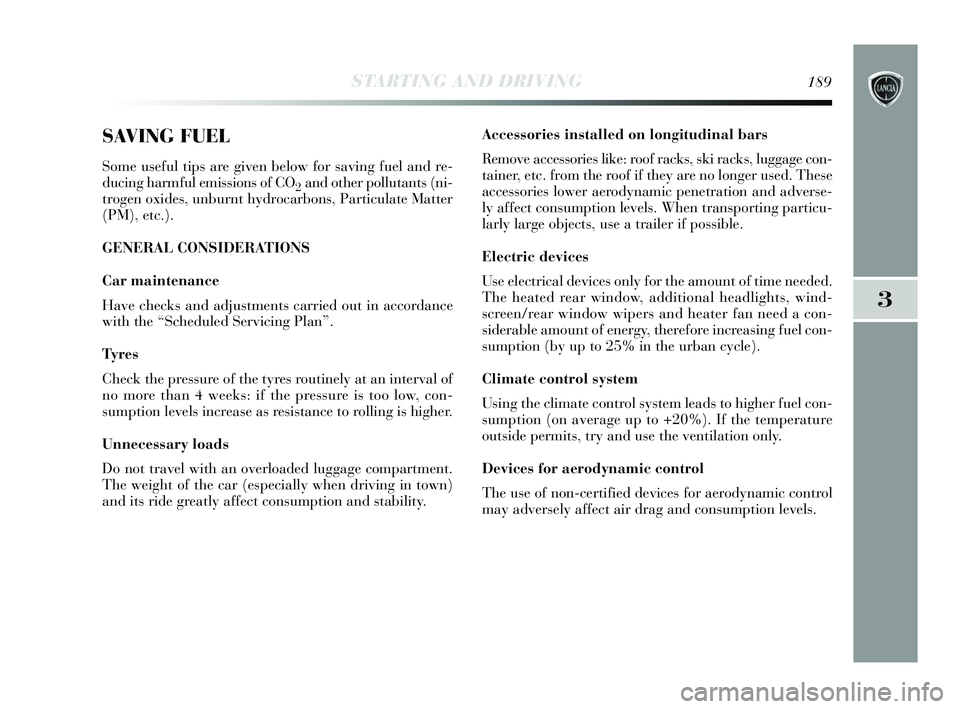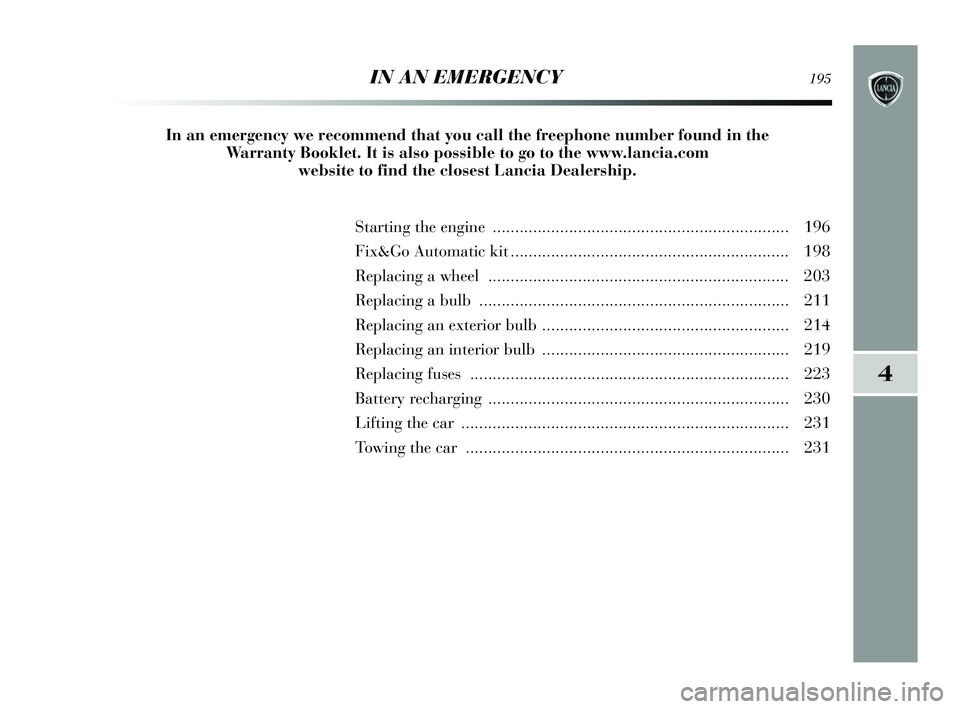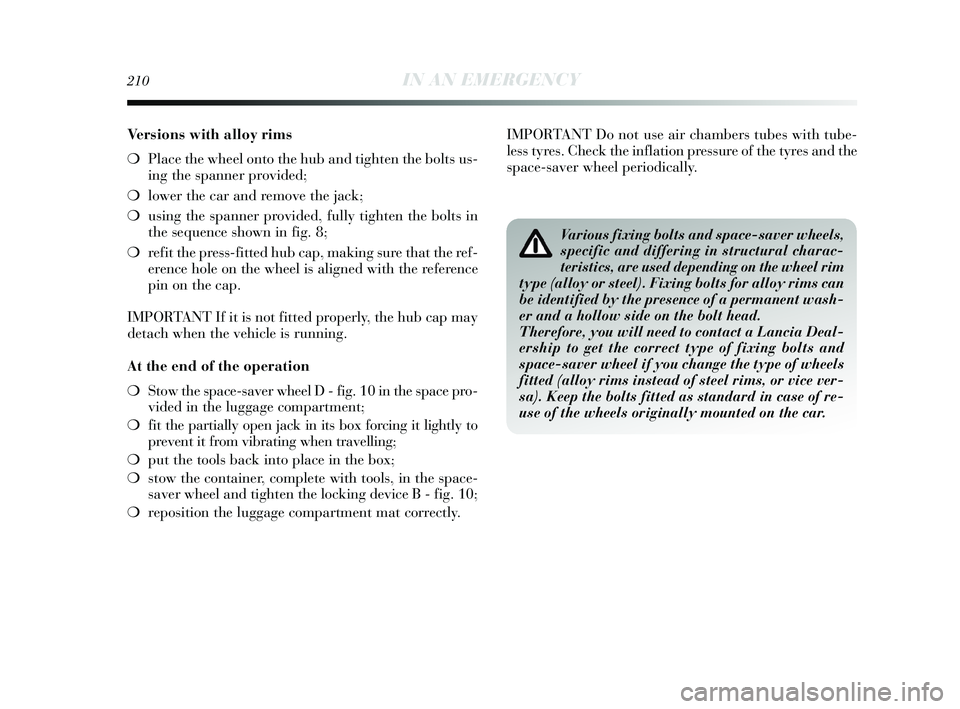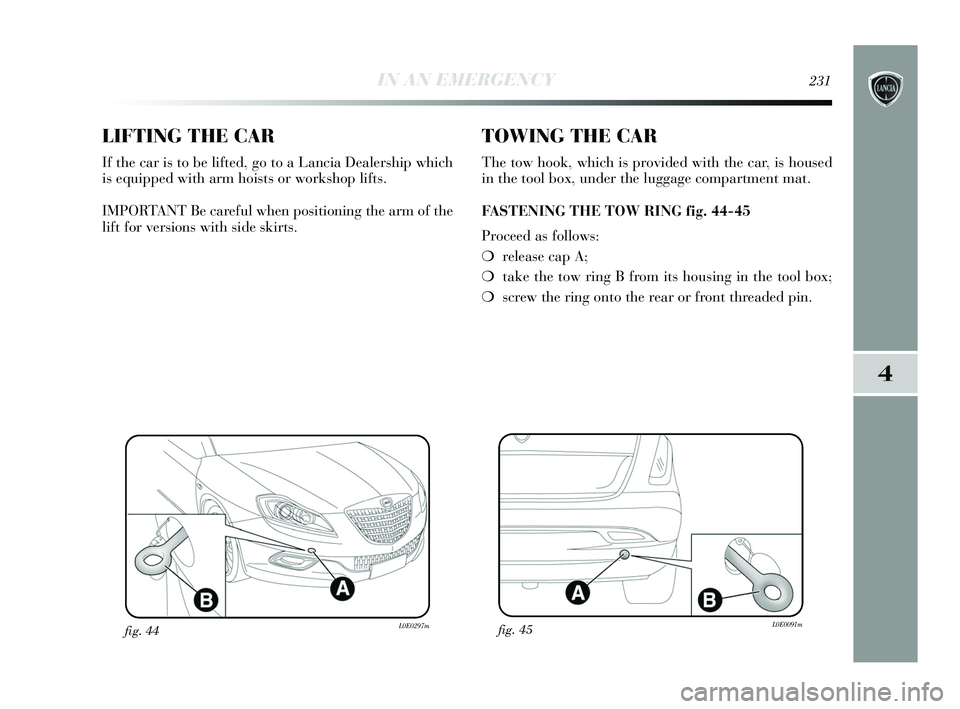tow Lancia Delta 2015 Owner handbook (in English)
[x] Cancel search | Manufacturer: LANCIA, Model Year: 2015, Model line: Delta, Model: Lancia Delta 2015Pages: 291, PDF Size: 6.74 MB
Page 191 of 291

STARTING AND DRIVING189
3
SAVING FUEL
Some useful tips are given below for saving fuel and re-
ducing harmful emissions of CO
2and other pollutants (ni-
trogen oxides, unburnt hydrocarbons, Particulate Matter
(PM), etc.).
GENERAL CONSIDERATIONS
Car maintenance
Have checks and adjustments carried out in accordance
with the “Scheduled Servicing Plan”.
Ty r e s
Check the pressure of the tyres routinely at an interval of
no more than 4 weeks: if the pressure is too low, con-
sumption levels increase as resistance to rolling is higher.
Unnecessary loads
Do not travel with an overloaded luggage compartment.
The weight of the car (especially when driving in town)
and its ride greatly affect consumption and stability. Accessories installed on longitudinal bars
Remove accessories like: roof racks, ski racks, luggage con-
tainer, etc. from the roof if they are no longer used. These
accessories lower aerodynamic penetration and adverse-
ly affect consumption levels. When transporting particu-
larly large objects, use a trailer if possible.
Electric devices
Use electrical devices only for the amount of time needed.
The heated rear window, additional headlights, wind-
screen/rear window wipers and heater fan need a con-
siderable amount of energy, therefore increasing fuel con-
sumption (by up to 25% in the urban cycle).
Climate control system
Using the climate control system leads to higher fuel con-
sumption (on average up to +20%). If the temperature
outside permits, try and use the ventilation only.
Devices for aerodynamic control
The use of non-certified devices for aerodynamic control
may adversely affect air drag and consumption levels.
183-194 Delta GB 1ed 26/08/13 12.15 Pagina 189
Page 192 of 291

190STARTING AND DRIVING
DRIVING STYLE
Cranking
Do not warm up the engine at low or high revs when the
car is stationary: under these conditions the engine warms
up much more slowly, increasing consumption and emis-
sions. It is therefore advisable to move off immediately,
slowly, avoiding high speeds: in this way the engine will
warm up more quickly.
Unnecessary actions
Avoid revving up when at traffic lights or before stopping
the engine. The latter action, like double-declutching, is
completely unnecessary and causes increased fuel con-
sumption and pollution.
Gear selection
As soon as the conditions of the traffic and road permit,
use a higher gear. Using a low gear for faster accelera-
tion will increase consumption.
In the same way improper use of a high gear increases con-
sumption, emissions and engine wear.
Max. speed
Fuel consumption considerably increases as speed in-
creases. Maintain a constant speed, avoiding unnecessary
braking and acceleration, which cost in terms of both fu-
el consumption and emissions.Acceleration
Accelerating violently will greatly affect consumption and
emissions: acceleration should be gradual.
CONDITIONS OF USE
Cold starting
Short journeys and frequent cold starts do not allow the
engine to reach optimum operating temperature. This re-
sults in a significant increase in consumption levels (from
+15 to +30% on the urban cycle) and emissions.
Traffic and road conditions
Rather high fuel consumption is caused by heavy traffic,
for instance when travelling in a queue with frequent use
of low gears or in large towns with many traffic lights.
Mountain and rough roads also have a negative effect on
fuel consumption.
Stops in traffic
During prolonged stops (e.g. level crossings) the engine
should be switched off.
183-194 Delta GB 1ed 26/08/13 12.15 Pagina 190
Page 193 of 291

STARTING AND DRIVING191
3
TOWING TRAILERS
IMPORTANT
For towing caravans or trailers the car must be fitted with
a certified tow hook and an adequate electrical system. In-
stallation should be carried out by specialised personnel
who will issue the required papers for travelling on roads.
Install any specific and/or additional door mirrors as spec-
ified by the Highway Code.
Remember that when towing a trailer, steep hills are hard-
er to climb, braking spaces increase and overtaking takes
longer depending on the overall weight.
Engage a low gear when driving downhill, rather than con-
stantly using the brake.
The weight the trailer exerts on the car tow hook reduces
the car’s loading capacity by the same amount. To make
sure that the maximum towable weight is not exceeded
(given in the car registration document) account should
be taken of the fully laden trailer, including accessories
and luggage.
Do not exceed the speed limits specific to each country you
are driving in, in the case of vehicles towing trailers. In
any case, the top speed must not exceed 100 km/h.
The ABS with which the vehicle may be
equipped does not control the braking system
of the trailer. Take specific care when trav-
elling on slippery roads.
Never modify the braking system of the car
to control the trailer brake. The trailer brak-
ing system must be fully independent from
the hydraulic system of the car.
183-194 Delta GB 1ed 26/08/13 12.15 Pagina 191
Page 197 of 291

4
IN AN EMERGENCY195
Starting the engine .................................................................. 196
Fix&Go Automatic kit.............................................................. 198
Replacing a wheel ................................................................... 203
Replacing a bulb ..................................................................... 211
Replacing an exterior bulb ....................................................... 214
Replacing an interior bulb ....................................................... 219
Replacing fuses ....................................................................... 223
Battery recharging ................................................................... 230
Lifting the car ........................................................................\
. 231
Towing the car ........................................................................\
231
In an emergency we recommend that you call the freephone number found in\
the
Warranty Booklet. It is also possible to go to the www.lancia.com website to find the closest Lancia Dealership.
195-232 Delta GB 1ed 03/03/14 09.14 Pagina 195
Page 199 of 291

IN AN EMERGENCY197
4
Proceed as follows to start the car:
❍connect the positive terminals (+ sign close to the ter-
minal) of both batteries using a lead;
❍ with a second lead, connect the negative terminal –
of the auxiliary battery to an earthing point E
on the
engine or the gearbox of the car to be started;
❍ start the engine;
❍ when the engine has been started, follow the sequence
above in reverse order to remove the leads.
If after a few attempts the engine does not start, do not
persist but contact a Lancia Dealership.
IMPORTANT Do not directly connect the negative ter-
minals of the two batteries: any sparks may ignite the ex-
plosive gas which could come out of the battery. If the aux-
iliary battery is installed on another car, prevent any con-
tact between metal parts of the two cars. BUMP STARTING
Never bump start the engine by pushing, towing or coast-
ing downhill.
This could cause fuel to flow into the catalytic converter
and damage it beyond repair.
IMPORTANT Remember that the brake servo and elec-
trical power steering system (where provided) are not op-
erational until the engine is started, a greater effort will
therefore be required to press the brake pedal or turn the
steering wheel.
195-232 Delta GB 1ed 03/03/14 09.14 Pagina 197
Page 200 of 291

198IN AN EMERGENCY
❍a compressor D - fig. 2 including a pressure gauge and
connectors, found in the compartment;
❍ a pair of protective gloves located in the side com-
partment of the compressor;
❍ adapters for inflating different elements.
The quick tyre repair kit also contains a screwdriver and
a tow hook.
fig. 3L0E0076m
FIX & GO AUTOMATIC KIT
The Fix & Go Automatic quick tyre repair kit is located
in the luggage compartment.
The kit fig. 2 includes:
❍ a bottle A containing sealant and fitted with:
– filler pipe B;
– an adhesive label C with the message “max. 80 km/h” to be applied in a position clearly visible by
the driver (on the dashboard) after repairing the tyre;
❍ informative leaflet (see fig. 3), used to ensure the cor-
rect use of the quick tyre repair kit and then given to
the personnel who will be handling the treated tyre;
fig. 2L0E0075m
195-232 Delta GB 1ed 03/03/14 09.14 Pagina 198
Page 207 of 291

IN AN EMERGENCY205
4
The driving characteristics of the car may
change when a space-saver wheel is fitted.
Avoid violent acceleration and braking,
abrupt steering and fast cornering. The total life
of a space-saver wheel is approximately 3,000 km,
after which it must be replaced by another wheel
of the same type. Never install a standard tyre on
a rim designed for use as a space-saver wheel. Have
the wheel repaired and refitted as soon as possi-
ble. Using two or more space-saver wheels at the
same time is forbidden. Do not apply grease to the
bolt threads before assembly: they might sponta-
neously unscrew.
Tool box (versions with HI-FI Bose)
There is a tool box located in the luggage compartment
for versions with HI-FI Bose.
This box contains:
❍ screwdriver;
❍ tow hook;
❍ wheel bolt spanner;
❍ wheel bolt access spanner;
❍ alloy rims centring device;
❍ jack. REMOVING THE SUBWOOFER
(versions with HI-FI Bose)
(for versions/markets, where provided)
IMPORTANT The following procedure only applies to cars
equipped with HI-FI Bose systems with subwoofer (for
versions/markets, where provided).
SUBWOOFER AND SPACE-SAVER WHEEL
Proceed as follows to remove the subwoofer:
❍
open the luggage compartment, pull tab A - fig. 10 and
lift up the mat;
❍ undo locking device A - fig. 8 and lift up the subwoofer.
Then remove connection cable B from velcro attach-
ment C;
fig. 8L0E0176m
195-232 Delta GB 1ed 03/03/14 09.14 Pagina 205
Page 212 of 291

210IN AN EMERGENCY
Versions with alloy rims
❍Place the wheel onto the hub and tighten the bolts us-
ing the spanner provided;
❍ lower the car and remove the jack;
❍ using the spanner provided, fully tighten the bolts in
the sequence shown in fig. 8;
❍ refit the press-fitted hub cap, making sure that the ref-
erence hole on the wheel is aligned with the reference
pin on the cap.
IMPORTANT If it is not fitted properly, the hub cap may
detach when the vehicle is running.
At the end of the operation
❍ Stow the space-saver wheel D - fig. 10 in the space pro-
vided in the luggage compartment;
❍ fit the partially open jack in its box forcing it lightly to
prevent it from vibrating when travelling;
❍ put the tools back into place in the box;
❍ stow the container, complete with tools, in the space-
saver wheel and tighten the locking device B - fig. 10;
❍ reposition the luggage compartment mat correctly. IMPORTANT Do not use air chambers tubes with tube-
less tyres. Check the inflation pressure of the tyres and the
space-saver wheel periodically.
Various fixing bolts and space-saver wheels,
specific and differing in structural charac-
teristics, are used depending on the wheel rim
type (alloy or steel). Fixing bolts for alloy rims can
be identified by the presence of a permanent wash-
er and a hollow side on the bolt head.
Therefore, you will need to contact a Lancia Deal-
ership to get the correct type of fixing bolts and
space-saver wheel if you change the type of wheels
fitted (alloy rims instead of steel rims, or vice ver-
sa). Keep the bolts fitted as standard in case of re-
use of the wheels originally mounted on the car.
195-232 Delta GB 1ed 03/03/14 09.15 Pagina 210
Page 214 of 291

212IN AN EMERGENCY
IMPORTANT When the weather is cold or damp or after
heavy rain or after washing, the surface of headlights or
rear lights may steam up and/or form drops of conden-
sation on the inside. This is a natural phenomenon due
to the difference in temperature and humidity between the
inside and the outside of the glass which does not indicate
a fault and does not compromise the normal operation of
lighting devices. The mist disappears quickly when the
lights are turned on, starting from the centre of the dif-
fuser, extending progressively towards the edges.
TYPES OF BULBS fig. 14
Various types of bulbs are fitted to your car:
A. Glass bulbs: they are press-fitted. Pull to remove them.
B. Bayonet type bulbs: to remove this type of bulb fromits holder press the bulb, turn it anticlockwise and re-
move it.
C. Tubular bulbs: to remove, release them from their con- tacts.
D-E. Halogen bulbs: to remove the bulb, release the clip holding the bulb in place.
fig. 14L0E0084m
195-232 Delta GB 1ed 03/03/14 09.15 Pagina 212
Page 233 of 291

IN AN EMERGENCY231
4
LIFTING THE CAR
If the car is to be lifted, go to a Lancia Dealership which
is equipped with arm hoists or workshop lifts.
IMPORTANT Be careful when positioning the arm of the
lift for versions with side skirts.
TOWING THE CAR
The tow hook, which is provided with the car, is housed
in the tool box, under the luggage compartment mat.
FASTENING THE TOW RING fig. 44-45
Proceed as follows:
❍release cap A;
❍ take the tow ring B from its housing in the tool box;
❍ screw the ring onto the rear or front threaded pin.
fig. 44L0E0297mfig. 45L0E0091m
195-232 Delta GB 1ed 03/03/14 09.15 Pagina 231